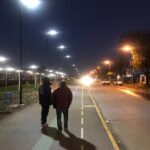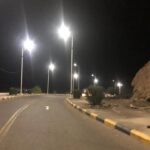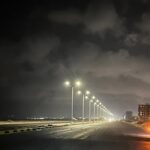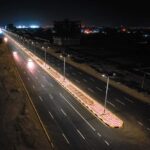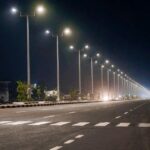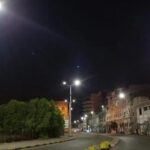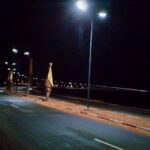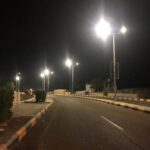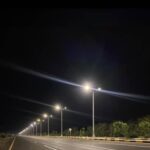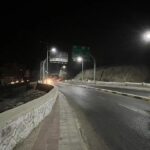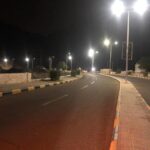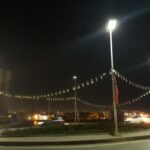The purpose of an automatic solar street light project is to introduce automation features in the operation of the solar street light. An automatic solar street light is an intelligent system, which is capable of operating in accordance with the real-time data. The purpose of automation is to ensure that the solar street light is operating when it is needed the most while it is turned off when it is not required. Study factors for consideration of solar lights cost.
Benefits of automation in street lights
Solar street lights usually operate at night since the natural light at night is much less. They need to stay off during the daytime when there is ample solar isolation from the sun available. When the sun starts to set, levels of natural light in the atmosphere and visibility start to decrease. Therefore, it is important for solar lights to turn on when the visibility drops after a certain level. In case, the automation is available with the solar street light then it will automatically turn on by analyzing the visibility data provided by a sensor.
However, when the sun rises again in the morning, the visibility level rises due to the presence of natural light in the atmosphere. Therefore, under some circumstances, there is no need to operate the light and it is more viable to conserve energy by turning it off. An automatic solar street light will also be able to turn off the light under some circumstances.
Users will need to perform an automatic solar street light project in order to achieve this functionality. However, in order to introduce this functionality, experts recommend expensive sensors, which can significantly affect the budget of the people. Therefore, in this article, we will explain a process with the help of which people can carry out an automatic solar street light project in a highly cost-effective manner. We will implement the project using a light-dependent resistor commonly known as an LDR.
Properties of an LDR
LDR is one of the most popular and significant resistors available in the electronics industry. The electronics industry, the use of LDR is common and a number of important devices operate using its properties. An LDR is basically a light-dependent resistor, which means that the operation of the resistor is dependent upon the provision of the light. When light shines on an LDR, it starts operating and it turns off in the absence of the light source.
Therefore, it is viable to use the light-dependent resistor LDR in a solar street light as well because the automation in solar street light also relies on the intensity of light in the atmosphere. An LDR will be able to control a solar street light since its own operation is dependent upon the presence or absence of light in the atmosphere.
Using LDR to introduce automation in solar street lights
In this section of the article, we will discuss the method with the help of which people can introduce automation in their solar street lights. However, it will be necessary for people to have access to the tree of the solar street light for carrying out the automatic solar street light project. Similarly, it is also important for people to have a significant level of designing and engineering skills because otherwise there is a risk of damage to the circuitry of the street light system.
Components necessary for performing the Automatic street light system project
Below is a list of all the components necessary for introducing automation in a street light circuit:
- Light-dependent resistor (LDR): It will perform the function of a sensor and detect the intensity of light in the atmosphere and operate the streetlight accordingly.
- Transistor: It is one of the most popular components in the electronics industry and it can perform the task of a controller when it is operating in combination with a light-dependent resistor.
- Resistors: Different sizes of resistors will be necessary in order to complete the circuitry.
- Breadboard: In order to implement the circuit in a practical manner, we recommend using a breadboard, which provides an ability to make custom circuits in a highly convenient manner. Once a circuit has been implemented on a breadboard then it is more suitable to translate it in printed circuit board form and use in the solar street light system.
- Battery: In order to test the system, users will need a battery in order to provide power to different components.
- Wires: In order to provide power to different components in the system, wires will be necessary.
Implementation of the automatic street light project
Once the users have obtained all the necessary components required for performing the process, then they move ahead with the implementation process. In the implementation stage, they will have to implement an electronic circuit using the transistor and an LDR.
Algorithm
Transistor controls the operation of the solar street light and when it sends a signal, the street light turns off and when no signal is available then solar street light turns on. The operation of the transistor will be dependent upon the operation of the light-dependent resistor. This can be implemented by ensuring that the input of the transistor is the output of the light-dependent resistor. In this way, the transistor will only operate when it receives a signal from the LDR.
Similarly, LDR depends upon the presence of light in the atmosphere for its operation. In case, no light is available in the atmosphere or it is below the limit necessary for the operation of the LDR then the resistor will not provide input to the transistor. On the other hand, when light is present in the system atmosphere, then the LDR will also operate and send a signal to the transistor, which will then send a signal and stop the operation of the solar street light.
This is an intelligent and highly cost-effective way of introducing automation in the street light system as LDR is usually available at cheap price in the market.
Automatic solar street light project: Conclusion
Light-dependent resistor (LDR) is a cost-effective and efficient way of introducing automation feature in a solar street light. It will turn the light on or off depending upon the level of natural light in the atmosphere, which will also increase the overall power consumption and operation efficiency of the street light. Similarly, the algorithm of implementation is also simple and people with basic electronics skills will be able to implement it.
You may want to check out What are the most significant solar park lights led parameters?



